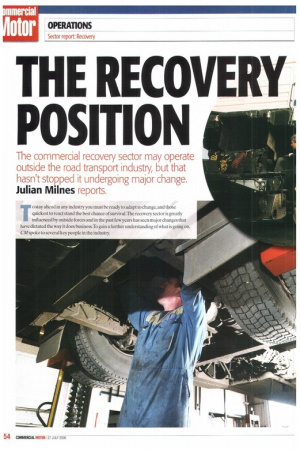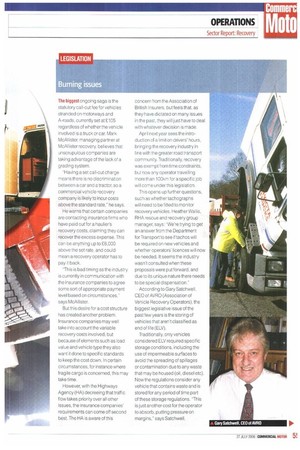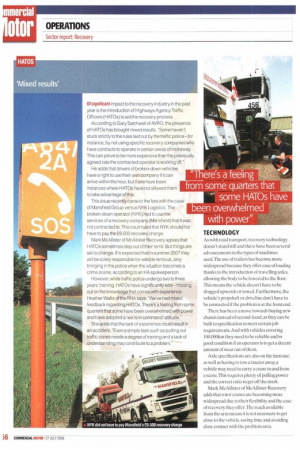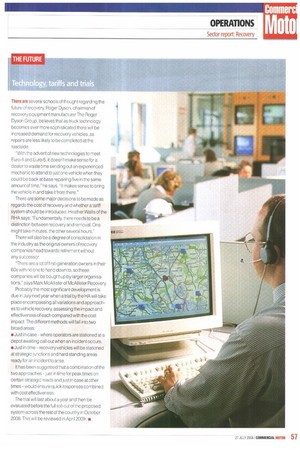THE RECOVERY POSITION
Page 54

Page 55

Page 56

Page 57

If you've noticed an error in this article please click here to report it so we can fix it.
The commercial recovery sector may operate outside the road transport industry, but that hasn't stopped it undergoing major change. Julian Nines reports.
To stay ahead in any industry you must be ready to adapt to change, and those quickest to react stand the best chance of survival.The recovery sector is greatly influenced by outside forces and in the past few years has seen major changes that have dictated the way it does business. To gain a further understanding of what is going on. CM spoke to several key people in the industry The biggest ongoing saga is the statutory call-out fee for vehicles stranded on motorways and A-roads, currently set at £105 regardless of whether the vehicle involved is a truck or car. Mark McAllister, managing partner at McAllister recovery, believes that unscrupulous companies are taking advantage of the lack of a grading system.
"Having a set call-out charge means there is no discrimination between a car and a tractor, so a commercial vehicle recovery company is likely to incur costs above the standard rate," he says.
He warns that certain companies are contacting insurance firms who have paid out for a haulier's recovery costs, claiming they can recover the excess expense. This can be anything up to £8,000 above the set rate. and could mean a recovery operator has to pay it back.
'This is bad timing as the industry is currently in communication with the insurance companies to agree some sort of appropriate payment level based on circumstances," says McAllister.
But this desire for a cost structure has created another problem. Insurance companies may well take into account the variable recovery costs involved, but because of elements such as load value and vehicle type they also want it done to specific standards to keep the cost down. In certain circumstances, for instance where fragile cargo is concerned, this may take time.
However, with the Highways Agency (HA) decreeing that traffic flow takes priority over all other issues, the insurance companies' requirements can come off second best. The HA is aware of this concern from the Association of British Insurers, but feels that, as they have dictated on many issues in the past, they will just have to deal with whatever decision is made.
April next year sees the introduction of a limit on drivers' hours, bringing the recovery industry in line with the greater road transport community. Traditionaily, recovery was exempt from time constraints, but now any operator travelling more than 100km for a specific job will come under this legislation.
This opens up further questions, such as whether tachographs will need to be fitted to monitor recovery vehicles. Heather Wallis, RHA rescue and recovery group manager, says: "We're trying to get an answer from the Department for Transport to see if tachos will be required on new vehicles and whether operators' licences will now be needed. It seems the industry wasn't consulted when these proposals were put forward, and due to its unique nature there needs to be special dispensation."
According to Gary Satchwell, CEO of AVRO (Association of Vehicle Recovery Operators), the biggest legislative issue of the past few years is the storing of vehicles that aren't classified as end of life (ELV).
Traditionally, only vehicles considered ELV required specific storage conditions, including the use of impermeable surfaces to avoid the spreading of spillages or contamination due to any waste that may be housed (oil, diesel etc). Now the regulations consider any vehicle that contains waste and is stored for any period of time part of these storage regulations. 'This is just another cost for the operator to absorb, putting pressure on margins," says Satchwell. Of significant impact to the recovery industry in the past year is the introduction of Highways Agency Traffic Officers (HATOs) to aid the recovery process.
According to Gary Satchwell of AVRO, the presence of HATOs has brought mixed results. Some haven't stuck strictly to the rules laid out by the traffic police -for instance, by not using specific recovery companies who have contracts to operate in certain areas of motorway. This can prove to be more expensive than the previously agreed rate the contracted operator is working off."
He adds that drivers of broken-down vehicles have a right to use their own company if it can arrive within the hour, but there have been instances where HATOs have not allowed them to take advantage of this.
This issue recently came to the fore with the case of Mansfield Group versus NYK Logistics. The broken-down operator (NYK) had to use the services of a recovery company (Mansfield) that it was not contracted to. This court ruled that NYK should not have to pay the £9,500 recovery charge.
Mark McAllister of McAllister Recovery agrees that HATOs sometimes step out of their remit. But things are set to change. It is expected that in summer 2007 they will be solely responsible for vehicle removal, only bringing in the police when the situation becomes a crime scene, according to an HA spokesperson.
However, while traffic police undergo two to three years' training, HATOs have significantly less-missing out on the knowledge that comes with experience. Heather Wallis of the RHA says: "We've had mixed feedback regarding HATOs. There's a feeling from some quarters that some have been overwhelmed with power and have adopted a 'we're in command' attitude."
She adds that the lack of experience could result in an accident. "Even a simple task such as putting out traffic cones needs a degree of training and a lack of understanding may contribute to a problem."
TECHNOLOGY As with road transport, recovery technology doesn't stand still and there have been several advancements in the types of machines used.The use of trailers has become more widespread because they offer ease of loading thanks to the introduction of travelling axles, allowing the body to be lowered to the floor. This means the vehicle doesn't have to be dragged upwards or towed. Furthermore, the vehicle's propshaft or driveline don't have to be connected if the problem is at the front end.
There has been a move towards buying new chassis instead of second-hand, as they can he built to specification to meet certain job requirements And with vehicles covering 100.000km they need to be reliable and in good condition if an operator is to get a decent amount of wear out of them.
Axle specifications are also on the increase; as well as having to tow a tractor away, a vehicle may need to carry a crane to and from a scene.This requires plenty of pulling power and the correct ratio to get off the mark.
Mark McAllister of McAllister Recovery adds that rotor cranes are becoming more widespread due to their flexibility and the ease of recovery they offer. The reach available from the arm means it is not necessary to get close to the vehicle, saving time and avoiding close contact with the problem area. There are several schools of thought regarding the future of recovery. Roger Dyson, chairman of recovery equipment manufacturer The Roger Dyson Group, believes that as truck technology becomes ever more sophisticated there will be increased demand for recovery vehicles, as repairs are less likely to be completed at the roadside.
"With the advent of new technologies to meet Euro-4 and Euro-5, it doesn't make sense for a dealer to waste time sending out an experienced mechanic to attend to just one vehicle when they could be back at base repairing five in the same amount of time," he says. "It makes sense to bring the vehicle in and take it from there."
There are some major decisions to be made as regards the cost of recovery and whether a tariff system should be introduced. Heather Wallis of the RHA says: "Fundamentally, there needs to be a distinction between recovery and removal. One might take minutes, the other several hours."
There will also be a degree of consolidation in the industry as the original owners of recovery companies head towards retirement without any successor.
"There are a lot of first-generation owners in their 60s with no one to hand down to, so these companies will be bought up by larger organisations," says Mark McAllister of McAllister Recovery.
Probably the most significant development is due in July next year when atrial by the HA will take place encompassing all variations and approaches to vehicle recovery, assessing the impact and effectiveness of each compared with the cost impact. The different methods will fall into two broad areas: • Just in case where operators are stationed at a depot awaiting call-out when an incident occurs.
• Just in time recovery vehicles will be stationed at strategic junctions and hard standing areas ready for an incident to arise.
It has been suggested that a combination of the two approaches just in time for peak times on certain strategic roads and just in case at other times -would ensure quick responses combined with cost effectiveness.
The trial will last about a year and then be evaluated before the full roll-out of the proposed system across the rest of the country in October 2008. This will be reviewed in April 2009. •
























































































































































































